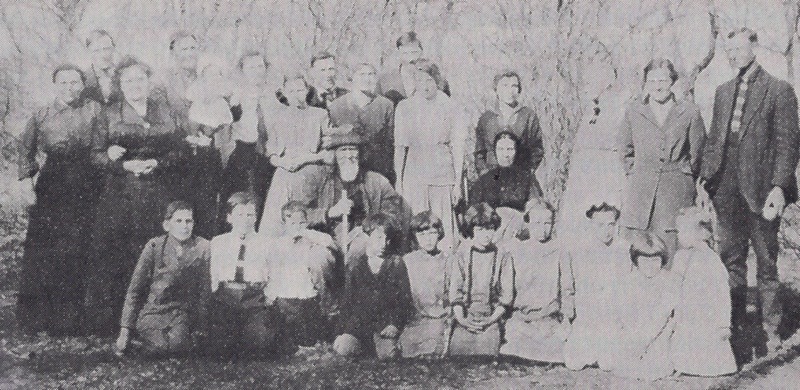After accusing Edna Lovewell of haunting me, I turned right around and stalked her.
When I learned that many University of Nebraska yearbooks are online for browsing, I began going through a handful of them looking for her picture. It was a long shot. Edna was a non-traditional student, probably not a joiner, just a hardworking woman in her early thirties finally earning her degree, soon to realize her dream of becoming a lawyer. Fortunately, leafing through yearbooks for the early 1930’s was a happy chore. Aside from their historic interest, the books are beautiful, full of art deco motifs and doodads that would be right at home adorning the cover of a modern reprint of “Gatsby” or “Atlas Shrugged.”
The ads they contain illuminate an era that seemed equally devoted to staring back adoringly at a proud heritage and looking ahead to the limitless future, one crowned by skyscrapers lit up by searchlights. There’s a set of paintings that cast the John Deere Plow Company in a nostalgic glow. This was Nebraska, after all. Full-page advertisements declaring, “Of course you’ll want your own x-ray unit!” remind us that the university included a dental college, but also that this was a culture on the cusp, sweaty frontiersmen sharpening plowshares alongside men in white smocks showing off their shiny new x-ray equipment. The word “holocaust” occurs in one retrospective, but only to describe a conflagration that burned down the popular student hangout, the Kosmet Klub. It must have been a tragic loss.
I gave up trying to find a photo of Edna, only to realize that I already had one, even though it’s not a clear one. She’s in the 1914 family portrait of children and grandchildren gathered around the elderly Thomas and Orel Jane Lovewell. It’s the one in which Thomas wears his roughed-up old cowboy hat and clutches his walking stick as if ready to bolt and follow a stream of prospectors to another Klondike. Edna is the slight figure behind Orel Jane, a 13-year-old girl hovering near her family, but also standing distinctly by herself. I tried to make something of this, wondering if Edna believed she belonged with these people, before remembering that her mother, Villa Viola VanMeter Lovewell, had died less than two years earlier, and Edna probably intended to leave a gap for her at her father’s side. She’s also the shortest person standing, so taking the spot behind her seated grandmother probably seemed a safe bet.

There were at least two pictures taken at the gathering. The other one shows Thomas and Orel Jane with their four children who were in attendance that day. All three sons were there, but of their three surviving daughters, only Mary lived nearby. She’s standing with her husband, Ben Stofer, on the right-hand edge of the picture above. It was a cold March day, judging from the blankets draped around the family’s elders, but Thomas had been feeling spry and wanted to ramble about in his yard. His wife spread the word that this would be a good time for a family get-together and someone thought to summon a photographer. This spur-of-the-moment reunion gives us two of the five known pictures of Thomas Lovewell and my only glimpse so far of his granddaughter, Edna Lovewell.
It’s hard to make out exactly what Edna is wearing, perhaps the Sunday-best for a typical schoolgirl in 1914, though at first glance it seems to be the doublet of a Tudor prince. In fact, she could have posed for the frontispiece of T. D. Rhodes’ perfumed romance about a “Young Lovell” about to go a-questing. I hope someone warned her about the dragons.
Photograph from “The Lovewell Family” by Gloria G. Lovewell ©1979